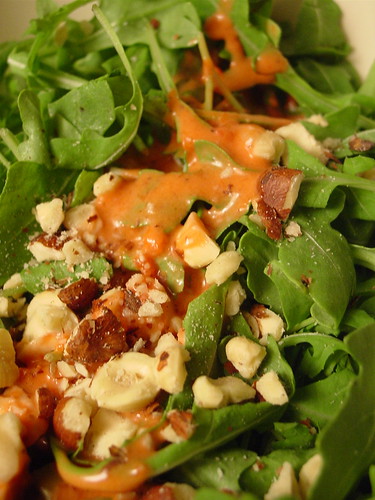Rocket/Arugula
[size=75]From Wikipedia, the free encyclopedia [/size]
Eruca sativa (syn. E. vesicaria subsp. sativa (Miller) Thell., Brassica eruca L.) is a species of Eruca native to the Mediterranean region, from Morocco and Portugal east to Jordan and Turkey.[1][2] It is closely related to Eruca vesicaria and included by some botanists in that either as a subspecies E. vesicaria subsp. sativa[3] or not distinguished at all;[4] it can be distinguished from E. vesicaria by its early deciduous sepals.[3]
It is an annual plant growing to 20–100 cm tall. The leaves are deeply pinnately lobed with four to ten small lateral lobes and a large terminal lobe. The flowers are 2–4 cm diameter, arranged in a corymb, with the typical Brassicaceae flower structure; the petals are creamy white with purple veins, and the stamens yellow; the sepals are shed soon after the flower opens. The fruit is a siliqua (pod) 12–35 mm long with an apical beak, and containing several seeds. The species has a chromosome number of 2n = 22.[2][3][5]
Vernacular names include Garden Rocket,[3] Rocket,[2] Eruca,[2] Rocketsalad,[6] Arugula (Italian; also American English), Rugola (Italian), Rucola (Italian) Roquette (French) Rokka (Greek) and Rughetta (Italian). The term arugula (variations of Italian dialects around arigola) is used by the Italian diaspora in Australia and North America and from there picked up as a loan word to a varying degree in American and Australian English, particularly in culinary usage. The names ultimately all derive from the Latin word eruca, a name for an unspecified plant in the family Brassicaceae, probably a type of cabbage.[7]
It typically grows on dry, disturbed ground.[2][3]
The leaves are used as a food by the larvae of some Lepidoptera species, including Garden Carpet.
It is used as a leaf vegetable, which looks like a longer leaved and open lettuce. It is rich in vitamin C and iron. It is frequently cultivated, although domestication cannot be considered complete. It has been grown in the Mediterranean area since Roman times, and was considered an aphrodisiac. Before the 1990s it was usually collected in the wild and was not cultivated on a large scale or researched scientifically.
It is now cultivated in various places, especially in Veneto, Italy, but is available throughout the world. It is also locally naturalised away from its native range in temperate regions around the world, including northern Europe and North America.[2][6]
